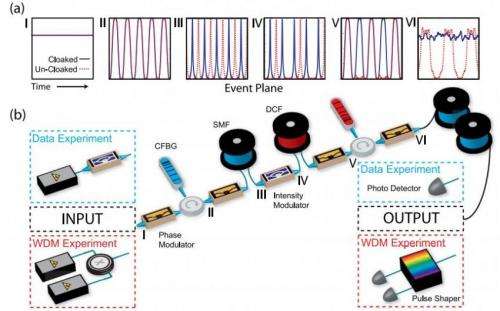December 1, 2014 report
Engineers build time cloak that hides messages in laser light

(Phys.org)—A team of engineers at Purdue University has succeeded in building a time cloak based on dual laser broadcast communications channels sent through a common medium. In their paper published in the journal Optica, the team describes how they improved on earlier work to create a time cloak that allows for hiding data in high-speed data communications.
Most people have heard of a cloaking device, it's a means of covering an object so as to prevent it from being seen. Less well known are time cloaks, which hide events rather than objects. A team of engineers at Purdue has been investigating this idea and last year, came up with a way to transfer data that was hidden, by time cloaking, across a communications channel. The drawback was that the approach was too successful, the data couldn't be read by anyone. Now, the team has improved their cloaking approach to the extent that it allows data to be time cloaked for transmission, and uncloaked by those that know how, all while keeping the data cloaked (hidden) from everyone else's perspective.
A time cloak works by masking evidence of the existence of an event. One way to do it is to control the flow of photons streaming from a laser. The idea is to insert data into a stream in a way that appears to the casual observer as steady, but in fact was interrupted to allow for data insertion, then resumed. Only those in the know beforehand would realize that data had ever existed in the stream. But, the catch is that those in the know must have a means for extracting that data—that's what the team at Purdue has now developed.
The device works by means of two communications channels based on lasers with two different frequencies. One of the frequencies is normal, in that it's not time cloaked. The second is time cloaked and thus events that occur in it are hidden, except from those that know how to access them. The light from both channels travels down the same length of fiber cable, allowing someone who knows about the cloaked channel to tap in to the correct one to gain access to the data it holds. This approach allows those in the know to access hidden data, and also to fend off interlopers hoping to disrupt the communications.
Besides being useful as a security measure, the researchers believe their technique could help improve high-speed data transmissions in the near future.
More information: Temporal cloaking for data suppression and retrieval, Optica, Vol. 1, Issue 6, pp. 372-375 (2014) dx.doi.org/10.1364/OPTICA.1.000372
Abstract
Recent research on time cloaking has revealed a fascinating approach to hide temporal events from an interrogating optical field, by opening up and subsequently closing intensity gaps in a probe beam. Experiments thus far have demonstrated temporal cloaking of nonlinear interactions and high-speed optical data. Here we report a temporal cloak with the new capability not only to hide optical data, but also to concurrently transmit it along another wavelength channel for subsequent readout, masking the information from one observer while directing it to another. Additionally, the cloak succeeds in passing modulated data unscathed through a scrambling event, providing a new form of tampering resistance. Both examples launch a paradigm shift in temporal cloaking: instead of using time cloaks primarily to disrupt communication, we show how they can also improve data transmission, in turn greatly widening the range of possible applications in telecommunications.
© 2014 Tech Xplore




















